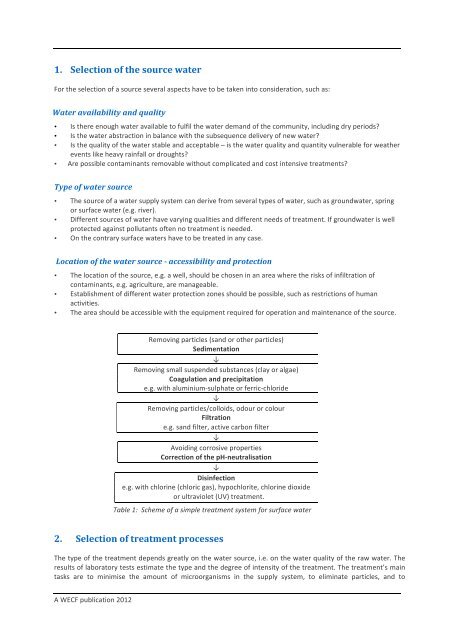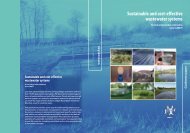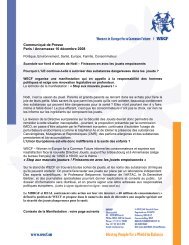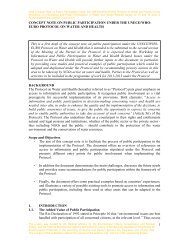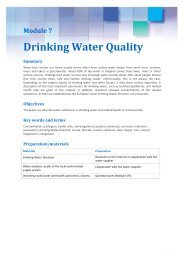Local Action for Safe Water - WECF
Local Action for Safe Water - WECF
Local Action for Safe Water - WECF
You also want an ePaper? Increase the reach of your titles
YUMPU automatically turns print PDFs into web optimized ePapers that Google loves.
1. Selection of the source water<br />
For the selection of a source several aspects have to be taken into consideration, such as:<br />
<strong>Water</strong> availability and quality<br />
• Is there enough water available to fulfil the water demand of the community, including dry periods?<br />
• Is the water abstraction in balance with the subsequence delivery of new water?<br />
• Is the quality of the water stable and acceptable – is the water quality and quantity vulnerable <strong>for</strong> weather<br />
events like heavy rainfall or droughts?<br />
• Are possible contaminants removable without complicated and cost intensive treatments?<br />
Type of water source<br />
• The source of a water supply system can derive from several types of water, such as groundwater, spring<br />
or surface water (e.g. river).<br />
• Different sources of water have varying qualities and different needs of treatment. If groundwater is well<br />
protected against pollutants often no treatment is needed.<br />
• On the contrary surface waters have to be treated in any case.<br />
Location of the water source -‐ accessibility and protection<br />
• The location of the source, e.g. a well, should be chosen in an area where the risks of infiltration of<br />
contaminants, e.g. agriculture, are manageable.<br />
• Establishment of different water protection zones should be possible, such as restrictions of human<br />
activities.<br />
• The area should be accessible with the equipment required <strong>for</strong> operation and maintenance of the source.<br />
A <strong>WECF</strong> publication 2012<br />
Removing particles (sand or other particles)<br />
Sedimentation<br />
↓<br />
Removing small suspended substances (clay or algae)<br />
Coagulation and precipitation<br />
e.g. with aluminium-‐sulphate or ferric-‐chloride<br />
↓<br />
Removing particles/colloids, odour or colour<br />
Filtration<br />
e.g. sand filter, active carbon filter<br />
↓<br />
Avoiding corrosive properties<br />
Correction of the pH-‐neutralisation<br />
↓<br />
Disinfection<br />
e.g. with chlorine (chloric gas), hypochlorite, chlorine dioxide<br />
or ultraviolet (UV) treatment.<br />
Table 1: Scheme of a simple treatment system <strong>for</strong> surface water<br />
2. Selection of treatment processes<br />
The type of the treatment depends greatly on the water source, i.e. on the water quality of the raw water. The<br />
results of laboratory tests estimate the type and the degree of intensity of the treatment. The treatment’s main<br />
tasks are to minimise the amount of microorganisms in the supply system, to eliminate particles, and to


